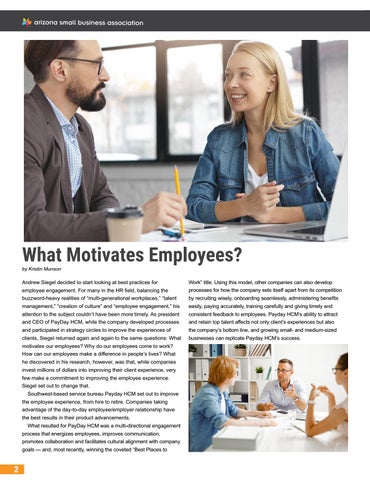What Motivates Employees? by Kristin Munson
Andrew Siegel decided to start looking at best practices for
Work” title. Using this model, other companies can also develop
employee engagement. For many in the HR field, balancing the
processes for how the company sets itself apart from its competition
buzzword-heavy realities of “multi-generational workplaces,” “talent
by recruiting wisely, onboarding seamlessly, administering benefits
management,” “creation of culture” and “employee engagement,” his
easily, paying accurately, training carefully and giving timely and
attention to the subject couldn’t have been more timely. As president
consistent feedback to employees. Payday HCM’s ability to attract
and CEO of PayDay HCM, while the company developed processes
and retain top talent affects not only client’s experiences but also
and participated in strategy circles to improve the experiences of
the company’s bottom line, and growing small- and medium-sized
clients, Siegel returned again and again to the same questions: What
businesses can replicate Payday HCM’s success.
motivates our employees? Why do our employees come to work? How can our employees make a difference in people’s lives? What he discovered in his research, however, was that, while companies invest millions of dollars into improving their client experience, very few make a commitment to improving the employee experience. Siegel set out to change that. Southwest-based service bureau Payday HCM set out to improve the employee experience, from hire to retire. Companies taking advantage of the day-to-day employee/employer relationship have the best results in their product advancements. What resulted for PayDay HCM was a multi-directional engagement process that energizes employees, improves communication, promotes collaboration and facilitates cultural alignment with company goals — and, most recently, winning the coveted “Best Places to
2





























